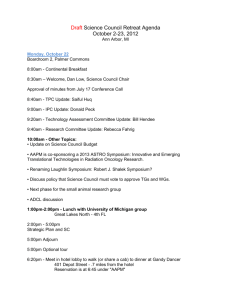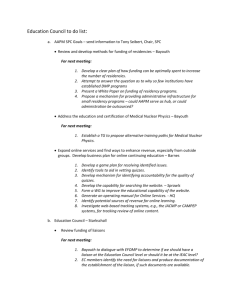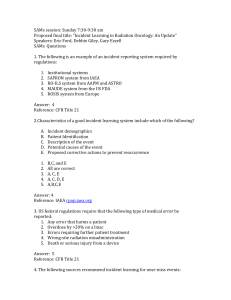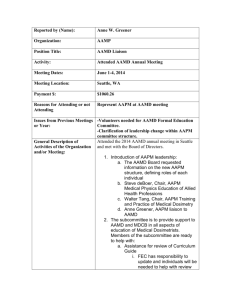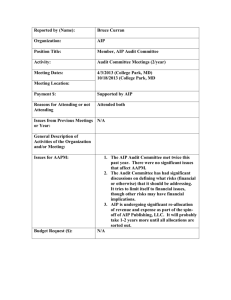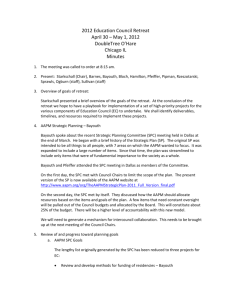AAPM Goals and Primary Discussion Issues
advertisement
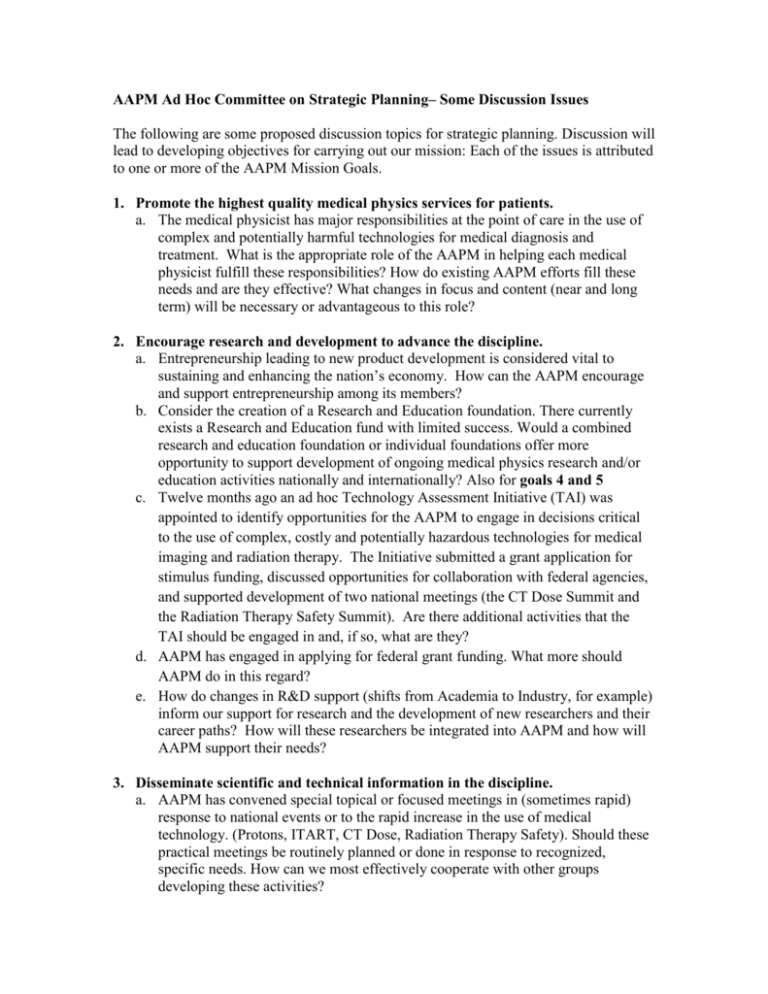
AAPM Ad Hoc Committee on Strategic Planning– Some Discussion Issues The following are some proposed discussion topics for strategic planning. Discussion will lead to developing objectives for carrying out our mission: Each of the issues is attributed to one or more of the AAPM Mission Goals. 1. Promote the highest quality medical physics services for patients. a. The medical physicist has major responsibilities at the point of care in the use of complex and potentially harmful technologies for medical diagnosis and treatment. What is the appropriate role of the AAPM in helping each medical physicist fulfill these responsibilities? How do existing AAPM efforts fill these needs and are they effective? What changes in focus and content (near and long term) will be necessary or advantageous to this role? 2. Encourage research and development to advance the discipline. a. Entrepreneurship leading to new product development is considered vital to sustaining and enhancing the nation’s economy. How can the AAPM encourage and support entrepreneurship among its members? b. Consider the creation of a Research and Education foundation. There currently exists a Research and Education fund with limited success. Would a combined research and education foundation or individual foundations offer more opportunity to support development of ongoing medical physics research and/or education activities nationally and internationally? Also for goals 4 and 5 c. Twelve months ago an ad hoc Technology Assessment Initiative (TAI) was appointed to identify opportunities for the AAPM to engage in decisions critical to the use of complex, costly and potentially hazardous technologies for medical imaging and radiation therapy. The Initiative submitted a grant application for stimulus funding, discussed opportunities for collaboration with federal agencies, and supported development of two national meetings (the CT Dose Summit and the Radiation Therapy Safety Summit). Are there additional activities that the TAI should be engaged in and, if so, what are they? d. AAPM has engaged in applying for federal grant funding. What more should AAPM do in this regard? e. How do changes in R&D support (shifts from Academia to Industry, for example) inform our support for research and the development of new researchers and their career paths? How will these researchers be integrated into AAPM and how will AAPM support their needs? 3. Disseminate scientific and technical information in the discipline. a. AAPM has convened special topical or focused meetings in (sometimes rapid) response to national events or to the rapid increase in the use of medical technology. (Protons, ITART, CT Dose, Radiation Therapy Safety). Should these practical meetings be routinely planned or done in response to recognized, specific needs. How can we most effectively cooperate with other groups developing these activities? b. The Medical Physics journal and the AAPM Newsletter are the principal communication venues of the AAPM for the dissemination of scientific, technical, educational and professional information. Are there areas in which these publications can be improved? Are there topics of interest to medical physicists that are not covered by the current publications, and what should be done to improve their coverage, if desirable? c. Discuss the status of the JACMP with respect to the AAPM goals and objectives. d. Many scientific and professional organizations are examining their “electronic presence” as an important feature of its public identity and recognition. What advantages might an enhanced electronic presence bring? What should be the electronic presence of the AAPM, and how can this best be achieved? 4. Foster the education and professional development of medical physicists. a. The AAPM has developed extensive guidelines for graduate and residency education and training of medical physicists, and these guidelines must be followed by programs seeking accreditation by the Commission on Accreditation of Medical Physics Education Programs (CAMPEP). However, there may be knowledge and skills that should be acquired by medical physicists but are not present in the guidelines. Examples include basic science (e.g. molecular biology and genetics, critical thinking and knowledge retention, and problem solving with complex systems. Should the guidelines include topics such as these and possibly others that may become more important in the next decade? b. The American Board of Radiology (ABR) lists six competencies that all persons certified by the ABR, including medical physicists, are expected to possess and demonstrate. The competencies are (1) Practice-based learning and improvement; (2) Patient care; (3) Professionalism; (4) Interpersonal and communication skills; (5) Knowledge; and (6) Systems-based practice. How well do medical physics graduate and residency programs instill and reinforce these competencies in students, and what is the role of the AAPM in ensuring that these competencies are possessed and practiced by its members? Should the changes in the previous issue specifically include these areas? c. Are the career pathways to enter the medical physics profession clearly defined and is supply balanced with (anticipated) demand for the various pathways? How can AAPM help? 5. Support the medical physics education of physicians and other medical professionals. a. The AAPM has collegial relations with several other organizations, including the Radiological Society of North America (RSNA), American College of Radiology (ACR), American Society of Radiation Oncologists (ASTRO), American Board of Radiology (ABR),American College of Cardiology (ACC), American Society of Radiologic Technologists (ASRT), and American Registry of Radiologic Technologists (ARRT). How well do these relations support the goal of providing medical physics education of physicians and other medical professionals, and how can this education be improved? b. The AAPM is financially supporting the production of web-based educational modules for radiologists in collaboration with the RSNA. These modules are useful also for educating medical physics graduate students. The AAPM is also producing web-based educational modules on ethics and professionalism in collaboration with RSNA, ABRF, ASTRO, ARS and ACR). Are there additional needs and opportunities for web-based educational modules and, if so, should they be pursued? 6. Promote standards for the practice of medical physics. a. How should AAPM promote and implement nationally consistent recognition of the Qualified Medical Physicist. Is the current definition of QMP consistent with modern practice? Should qualifying credentials associated with given practice subspecialty be more or less specific? Is the Scope of Practice a good model to follow to help in this definition? PP1 and PP17 attached. b. AAPM has many task groups and task group reports that collectively define a rather diffuse code of practice for medical physicists. Should these references be reviewed to begin the compilation of straightforward standards and practice guidelines for medical physicists? How should AAPM become involved in developing national practice guidelines/standards in radiation oncology and medical imaging? To what extent should AAPM encourage federal and state statutes and regulations to enforce practice standards in medical physics? In other words, how should qualifications, guidelines, accreditation and regulation/legislation be linked to improve patient safety and the quality of care and how can AAPM help? 7. Govern and manage the Association in an effective, efficient, and fiscally responsible manner. a. The AAPM has 4 councils (Scientific, Education, Professional and Administrative), reflecting the multiple interests and obligations of the Association. Does this structure effectively represent AAPM interests and activities, now and in the future? Is the current system of allocating revenue and expense to each council a fair representation of the priorities and needs of the AAPM membership? b. What should the primary and secondary sources of revenue for AAPM be? How do we enhance them? c. Are long term financial commitments appropriate, and if so, over what term and in what areas? d. The discipline of radiology has a scientific and education association (RSNA) with a parallel college (ACR) to handle professional matters. While in radiation e. f. g. h. oncology, ASTRO handles most professional, educational and scientific matters, there is a parallel college (ACRO) that duplicates some of the professional effort. The AAPM also has a parallel college (the American College of Medical Physics (ACMP)), but its activities have become principally educational, while most professional matters are handled by the AAPM Professional Council. Is this the most favorable arrangement for the AAPM and ACMP and, if not, how should it be changed? The AAPM Board of Directors has repeatedly struggled with reducing its size. However, management of the Association by a Board of 50 members is very unwieldy. How can this dilemma be resolved and the management of the AAPM be improved? The AAPM budgeting process is flawed and potentially hazardous to the longterm financial stability of the organization. Each year more money is allocated than is expected to be generated, with the hope that the budget will be balanced at year-end because some of the allocated funds are not used. The AAPM has ended with a negative bottom line at year-end for the past couple of years. Is the statistical model now being used an effective or desirable solution? Should the budgeting process be changed and, if so, how should it be changed? How do we equitably and effectively prioritize initiatives and allocate resources to carry out objectives discussed above. Consider bringing a part time medical physicist on permanent staff of AAPM to facilitate research and other activities that require a senior and experienced medical physicist (matches most other goals above as well). Final Meeting Objective Considering the achievements of this meeting, by what mechanism should AAPM continue the strategic planning process?

